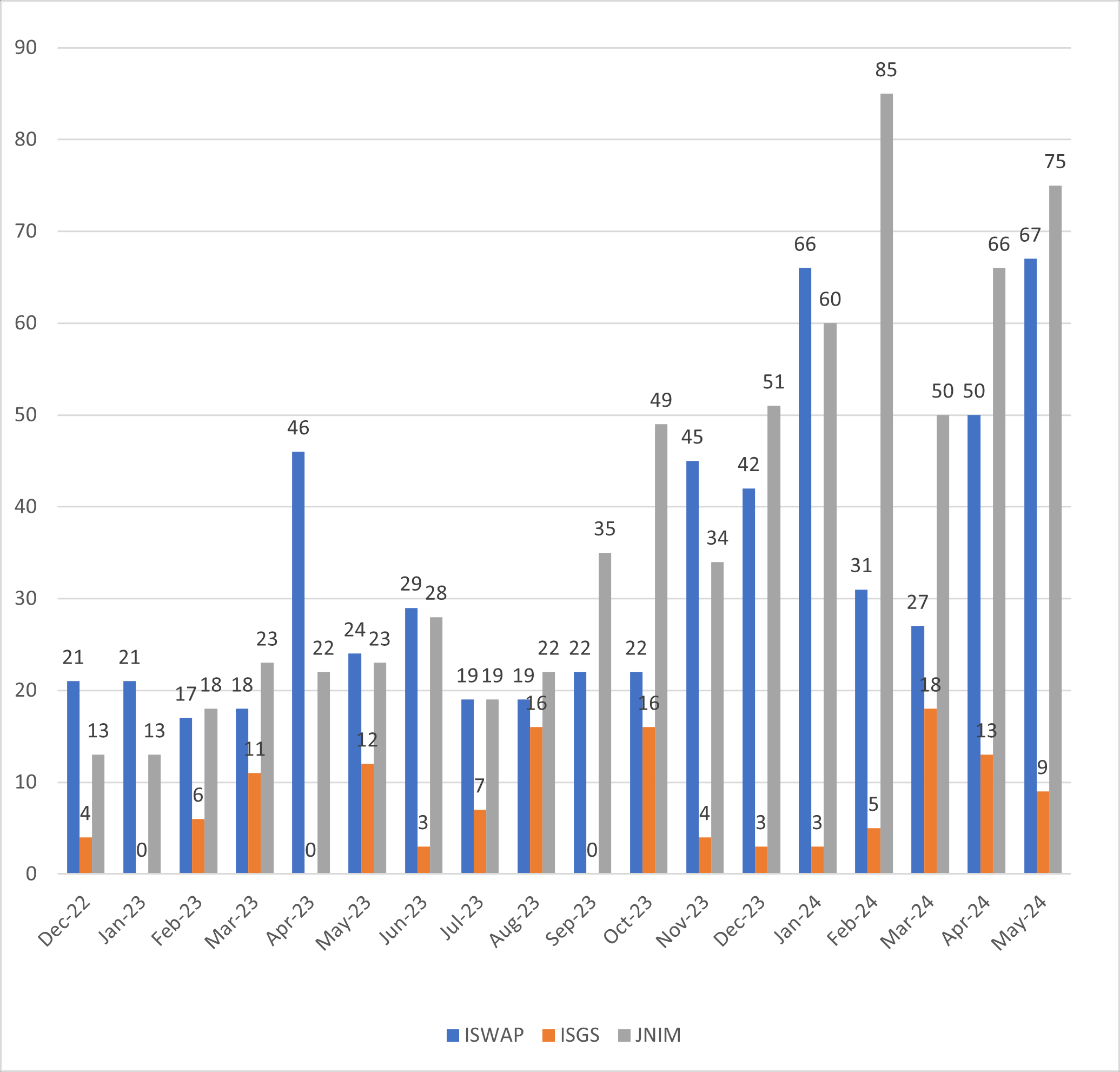The month of May saw a significant increase in social media output from both the Islamic State as well as JNIM–as was expected given the continuous rise of online activities of both groups in recent months. The number of statements published during the month of May reached their highest point since reporting began in December 2022. 151 statements were released by the Islamic State’s branches and JNIM, al-Qaeda’s representative in the Sahel.
ISWAP in particular increased its online activities and in May had the largest output of all three terror groups. 67 statements were published throughout the month of May in the five issues of an-Naba’, the Islamic State’s weekly magazine. The number of claims published by the other Islamic State’s Province in the area, the Islamic State in the Greater Sahara or Sahel Province (ISGS), on the other hand, remains remarkably low. As was observed during the entire report period, this is another indication that ISGS is very likely underreporting on its activities. Al-Qaeda’s Sahelian branch JNIM claimed the second highest number of operations since reporting started.
JNIM and ISGS also continued to portray themselves as the protectors of the civilian population by highlighting alleged atrocities committed by government forces and Russian mercenaries. On no less than 10 occasions JNIM and ISGS reported on crimes committed against the local population by the national armies of Mali and Burkina Faso. On seven occasions, involvement by the Russian Africa Crops – the former Wagner Group – was explicitly mentioned. JNIM claimed no less than 100 civilians were killed in Burkina Faso alone, while at least 46 were killed by the Malian army and the Russian mercenaries. The sole claim published by ISGS was not dated and just mentioned that several locals were killed and wounded in attacks by the Malian army and the Russian Africa Corps.
Attacks in the Sahel: General Trends
Unfortunately, the situation continues to be bleak and there is no reason for optimism concerning the spread of Jihadi violence throughout the region. The region saw an increase of Jihadi media output throughout the wider Sahel region by no less than 397%, an evolution that does not bode well for the months to come.
Meanwhile, Russian involvement in the region seems to be growing steadily, as is reflected by the propaganda output of the terror groups that are monitored for this report. More and more claims of massacres committed against the local populations of both Mali and Burkina Faso are being published, especially by al-Qaeda’s az-Zallaqa Media. Apart from the ten massacres mentioned earlier, the Wagner Group was targeted at least six times: four attacks were on the account of JNIM, while two were claimed by ISGS. The exact number of Russian mercenaries killed was not mentioned by either of the groups involved. This again highlights that the Russian presence in the region is not actually improving the security situation in a country like Mali; on the contrary, the chaos increases month by month.
Another very worrying trend is the increasing number of attacks by ISWAP in Nigeria and Niger on the International Committee of the Red Cross (ICRC) and African Coalition Forces. No less than 10 attacks on the Red Cross (5) and the African Coalition Forces (5) were registered in May. Two suicide vehicle borne improvised explosive devices (SVBIED) attacks were conducted by ISWAP and led to more than 40 casualties in the ranks of the African Coalition. Infighting between ISGS and JNIM also continued in both Mali and Burkina Faso, with three such attacks occurring in May, all with an unknown number of casualties.
Furthermore, a very worrying trend that especially manifests itself in Nigeria consists of very large Da’wa (prosetylizing) events organised in the country by ISWAP, and to a lesser extent by JNIM in Mali. With such activities, the Islamic State is following the strategy it followed a decade ago in Syria and Iraq. This strategy includes not only preaching and proselytization but also activities of the Hisba (moral “police”). This part of the terror group is now widely active throughout Nigeria as has been confirmed by dozens of pictures published during the month of May by the terror group. In one of the reports published by ISWAP, it was claimed that the Hudud (Islamic Penal Law) was applied for drinking and theft, resulting in lashing and the amputation of the thief’s right hand.
Table 1: Claimed Attacks (December 2022 – May 2024)
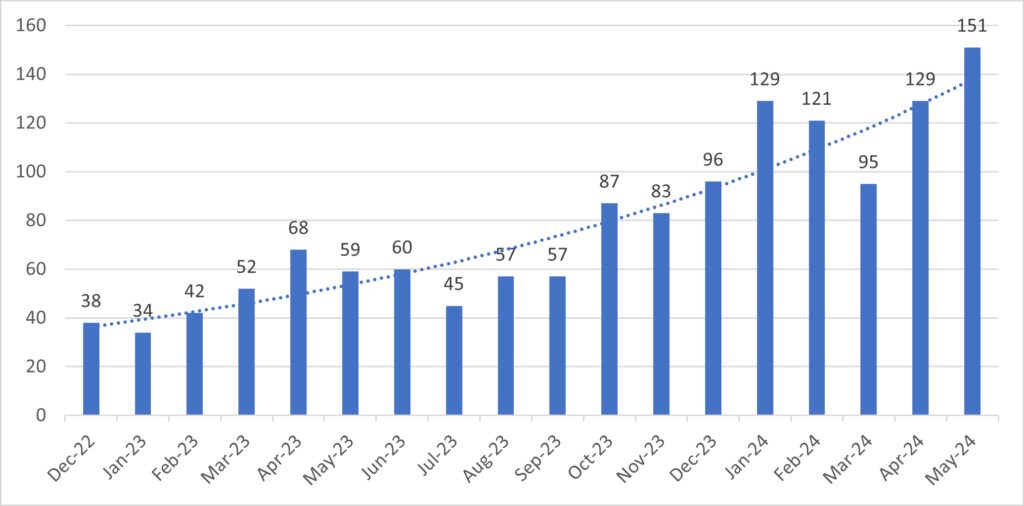
Table 2: Claimed Attacks per Group (December 2022 – May 2024)
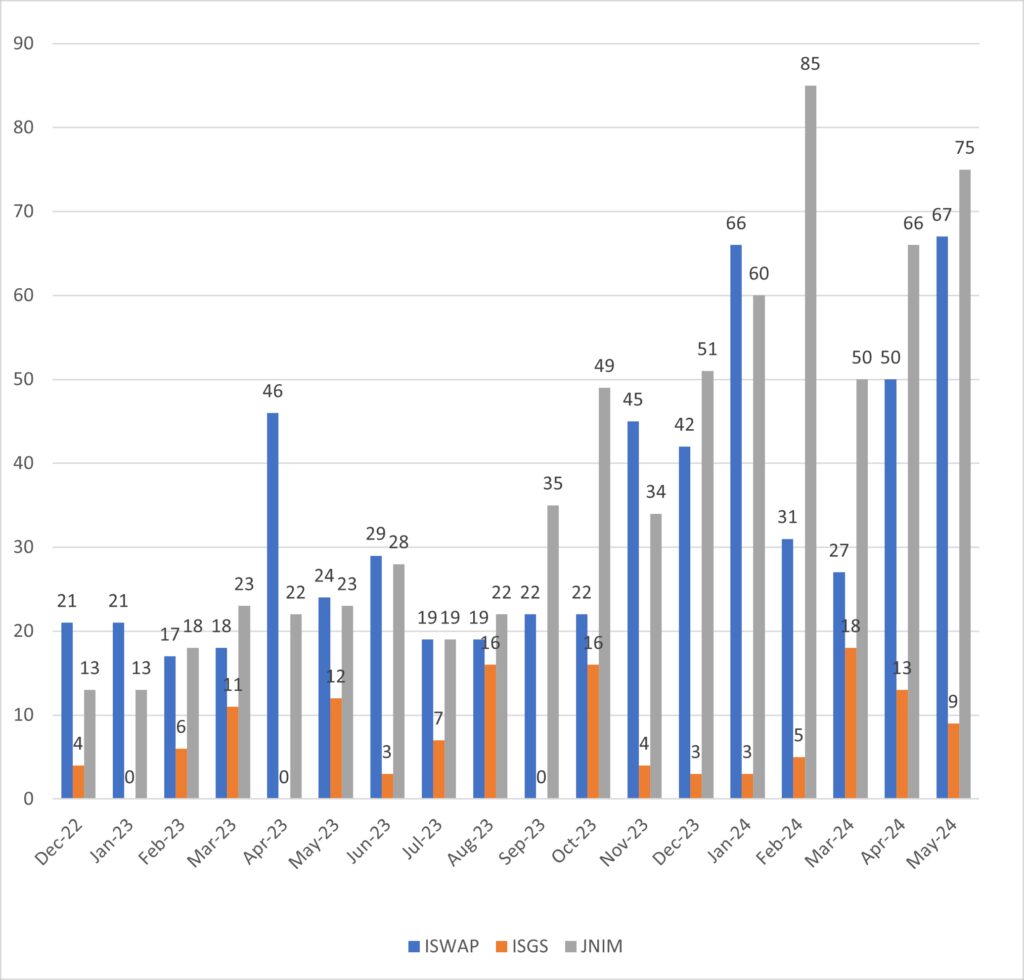
Table 3: Claimed Attacks per Country (December 2022 – May 2024)
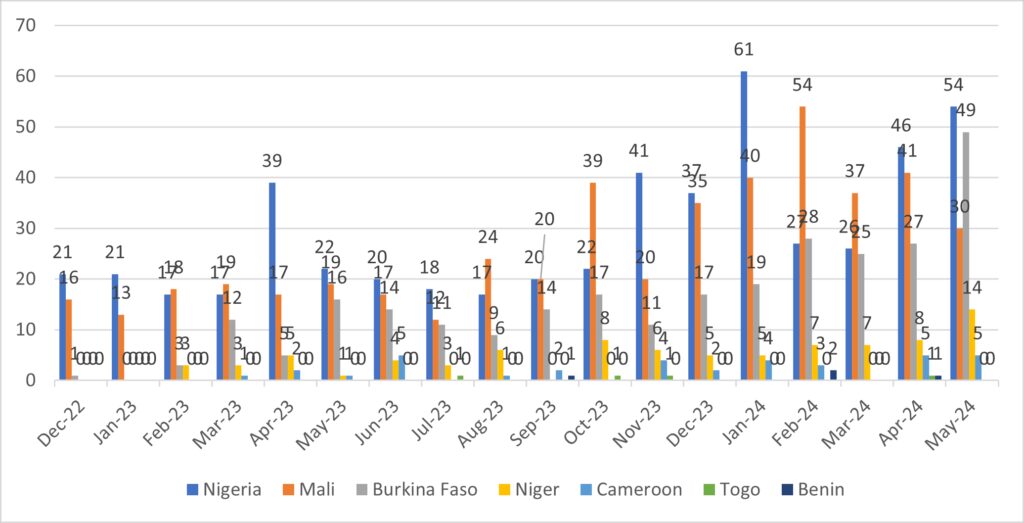
Attacks per Country
NigeriaNo less than 54 incidents were claimed in Nigeria: as previously mentioned, this number includes more than just the low-level terror attacks that were observed in previous months. Most remarkable in Nigeria were the Da’wa and Hisba campaigns, of which numerous picture sets were published by both ISWAP itself as well as by IS Central’s media channel an-Naba’.
During the month of May, ISWAP claimed three SVBIED attacks, all in Nigeria, mainly targeting the African Coalition forces. The exact number of casualties is unknown but the available material indicates that it likely exceeds 50 casualties. On at least 14 occasions some kind of improvised explosive devices (IED’s) were used, resulting in at least 72 victims killed or injured.
Burkina Faso49 attacks were claimed in Burkina Faso; three of these were claimed by ISGS, the rest by JNIM. These attacks resulted in at least 180 victims. 100 more people were killed by the Burkinabe army in indiscriminate attacks on the local population. 45 of the attacks by ISGS and JNIM were directed at the army or local militia. Two attacks were claimed by ISGS, targeting JNIM and killing and wounding 4 al-Qaeda fighters. On May 25, az-Zallaqa Media released a picture set of a training camp for their new recruits. This indicates that JNIM’s influence is growing in the region—not just in numbers but in terms of equipment and new capacities.
MaliMali was mentioned 30 times this month in Jihadi output. On five occasions, the Wagner Group was explicitly referred to, either as a target or as responsible for the multiple massacres committed. The situation in Mali continues to deteriorate month by month. By now, the Malian regime is highly dependent on Russian aid. However, this increasing Russian influence has not reversed the security situation, which is deteriorating rapidly. The number of casualties reported remains vague, but at least 46 civilians were claimed to have been killed by regime forces and Russian mercenaries of the former Wagner Group. One attack on the Malian Army resulted in a significant amount of stolen wealth for JNIM; hence the multiple pictures posted and infographic posted by az-Zallaqa Media showcasing the material that was captured by the terror group.
NigerNiger was hit 14 times during the month of May. Ten of these attacks were claimed by ISWAP, three by ISGS, and one incident was claimed by JNIM. This marks the highest number of attacks claimed in Niger since reporting began. It is clear that all Jihadi groups in the area are taking advantage of the destabilisation of the country after the military putsch earlier last year. Jihadi terrorist violence in the country resulted in more than 160 victims. The army and loyalist militia were the main targets, but ISWAP also claimed a total of three attacks on the ICRC, resulting in three casualties.
CameroonFive attacks were registered in Cameroon: all were claimed by ISWAP, targeting the army and loyalist militia and resulting in over 107 casualties.
Table 4: Total number of attacks
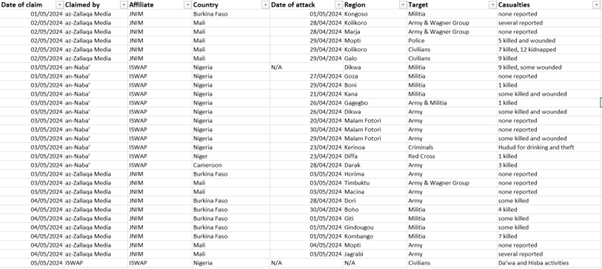
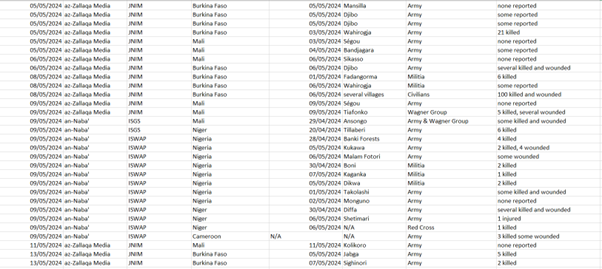
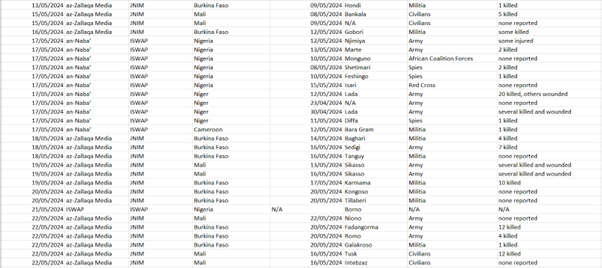
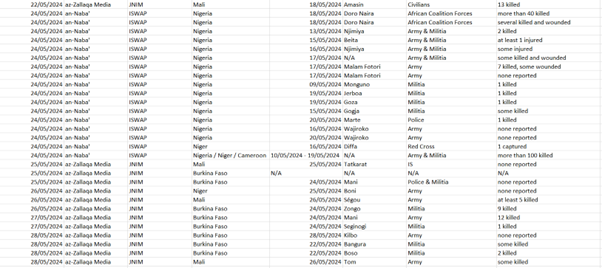
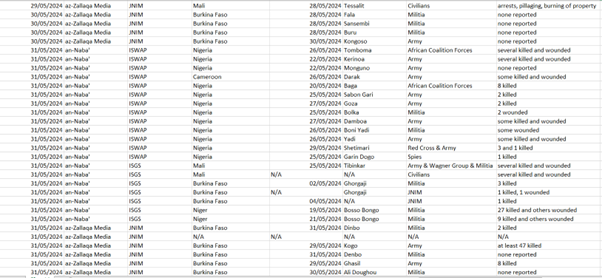
Claims per Affiliate
JNIM
Roughly half of all statements during the month of May were published by JNIM’s az-Zallaqa Media. 46 of these were attacks registered in Burkina Faso, targeting the army and militia members. Eight statements were published regarding atrocities committed by the army and the Wagner Group in which 46 civilians were killed. Four terrorist attacks were directly aiming at the Malian army and their Russian mercenaries, leading to an unknown number of casualties. All but one of these claimed terror attacks were IED attacks on mixed Malian-Russian patrols. The most significant attack occurred in Jagrabi, Mali, where a very large stock of weapons, ammunition, and vehicles were captured. Az-Zallaqa Media published an infographic on this attack.
Table 5: Claims by JNIM

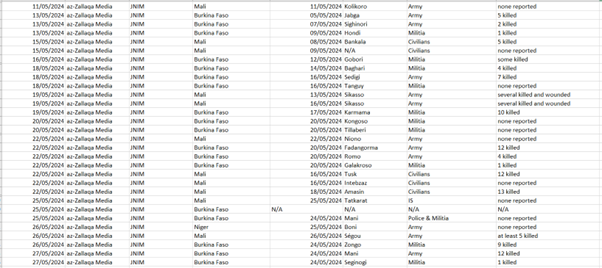
ISWAP
67 statements were published by ISWAP; most of them in Nigeria (54). However, Niger was also targeted with ten attacks. Three of these were aimed at the ICRC. Five attacks targeted the Cameroonian army and its affiliated militia. The 54 attacks in Nigeria mark the second highest number of attacks in the country since reporting started in December 2022. There were more attacks in Nigeria by ISWAP only in January 2024.
Table 6: Attacks by ISWAP
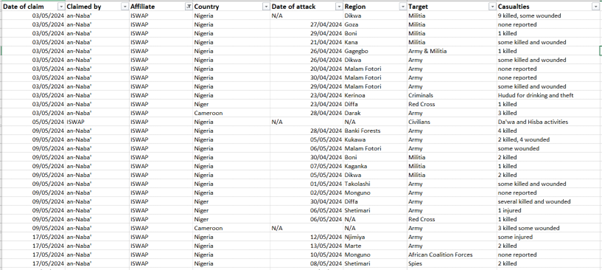
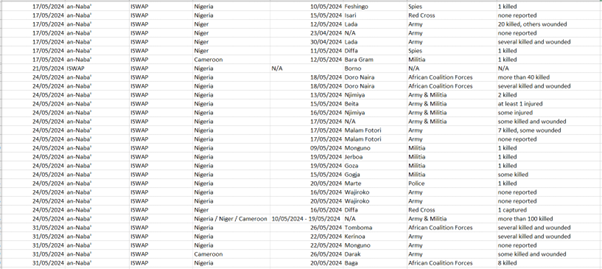
ISGS
Only nine statements were published by an-Naba’ Magazine on account of ISGS: three in Mali, three in Burkina Faso and three in Niger. One of the statements published concerned an alleged massacre committed by the Malian Army, its loyalist militia, and the former Wagner Group This is noteworthy because reports on alleged atrocities committeed by government forces and Russian mercenaries are usually published by JNIM’s az-Zallaqa Media. ISGS publishes such reports rather seldomly. This could be an indication that ISGS is now also shifting its propaganda angle in order to portray itself as the protector of the civilian population against the government and its henchmen. What is most striking is that the majority of the statements (7) were published in the last edition of IS Central’s propaganda outlet an-Naba’: Issue 445, distributed on May 31. Consequently, issue 445 of an-Naba’ (and al lot more of them in weeks before) could be characterised as the “Out of Africa” edition, increasingly highlighting operations in all it’s African Provinces. Almost all claimed attacks showcased in that issue originated from one of the Islamic State’s African Provinces. In this edition, the Islamic State reported 3 incidents in Burkina Faso and 2 in both Mali and Niger.
Table 7: Attacks by ISGS

Conclusion
Unfortunately, the negative trend observed during the last 18 months of reporting continues and there is little reason for optimism. As predicted one year ago, the situation in these countries, which are most affected by Jihadi-terrorist violence, is deteriorating rapidly. Mali, Burkina Faso, and Niger have reached such severe levels of chaos and anarchy that a rapidly increasing number of people are internally displaced, and/or try to flee to Europe by crossing the Atlantic from Mauritania to the Canary Islands. This situation is increasingly challenging for authorities in tourist destinations such as Tenerife and Gran Canaria.
However, it is unlikely that the level of migration from this region will reach similar levels as those that were observed in 2015 and 2016; therefore the effect of this migration flow on the internal security situation in Europe will be more medium to long term rather than short term. Migration from Syria via Turkey into the Schengen Zone was geographically easier; not only for refugees but also for Islamic State militants mingling among them. Nevertheless, given the increasing violence, chaos and anarchy in the Sahel region, migration and human smuggling from Northern Africa will continue to grow. The risk of course remains that among the refugees fleeing violence in the Sahel, ISWAP, ISGS or JNIM will plant operatives that attempt to enter Europe in order to plot and execute attacks in Western capitals, as was the case in Paris in 201) and Brussels in 2016. Therefore, going forward, it will be crucial to monitor any attempts by ISGS, ISWAP or JNIM in this regard.

